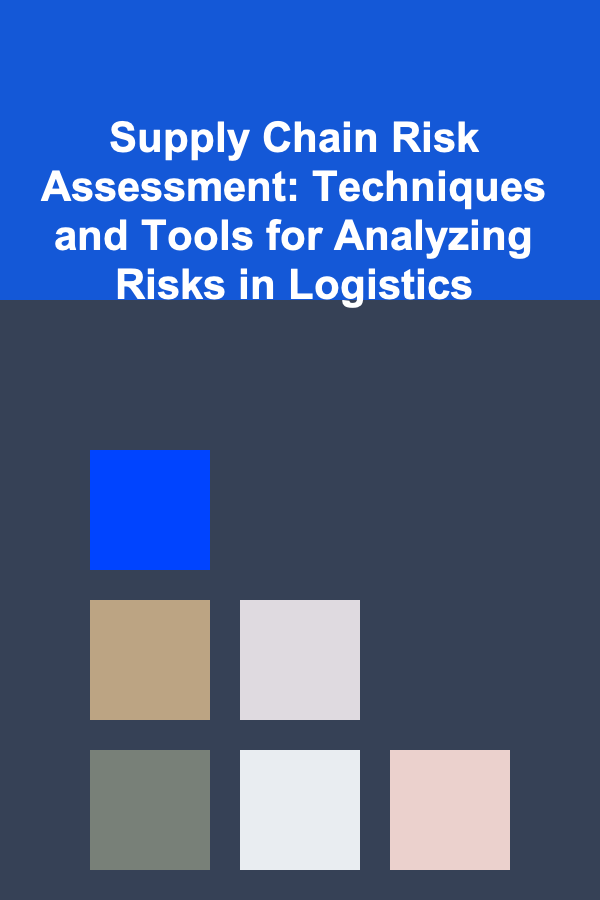
Supply Chain Risk Assessment: Techniques and Tools for Analyzing Risks in Logistics
ebook include PDF & Audio bundle (Micro Guide)
$12.99$8.99
Limited Time Offer! Order within the next:

In today's globalized business environment, supply chains are more complex and interconnected than ever before. With the rise of e-commerce, just-in-time inventory, and global sourcing, companies are exposed to a variety of risks that can disrupt operations, harm brand reputation, and incur financial losses. To ensure the resilience of their operations, businesses must assess and manage these risks proactively. This is where supply chain risk assessment comes into play.
A supply chain risk assessment is a systematic process of identifying, analyzing, and mitigating potential risks that could negatively affect a supply chain's performance. From transportation disruptions to supplier insolvencies, understanding these risks and preparing accordingly is crucial for businesses looking to maintain operational efficiency, meet customer expectations, and stay competitive.
In this article, we will dive deep into actionable techniques and tools that supply chain professionals can use to assess risks in logistics and develop strategies to mitigate them.
Understanding the Types of Supply Chain Risks
Before diving into techniques and tools, it's important to understand the different types of risks that can impact supply chains. These can broadly be categorized into the following:
1.1. Operational Risks
Operational risks are related to the internal processes of a supply chain. These risks are usually caused by inefficiencies or failures within the company's operations or the operations of its suppliers and partners.
- Inventory Management Failures: Poor stock management, such as overstocking or stockouts, can lead to unnecessary costs or inability to meet customer demand.
- Manufacturing Delays: Delays in production can lead to disruptions in supply and cause downstream delays.
- Process Inefficiencies: Any internal inefficiency, whether in procurement, production, or fulfillment, can disrupt the supply chain.
1.2. External Risks
External risks arise from factors outside of a company's control, including natural disasters, geopolitical events, or economic shifts.
- Natural Disasters: Hurricanes, earthquakes, floods, and other natural events can disrupt transportation routes, damage facilities, and halt production.
- Geopolitical Risks: Changes in government policies, trade wars, or conflict can impact global supply chains, affecting the cost and availability of materials.
- Economic Risks: Economic recessions, inflation, and currency fluctuations can affect the cost of goods and services, as well as demand for products.
1.3. Supply Risks
Supply risks occur when there is an issue with the supplier or the materials supplied. These risks can be a result of the supplier's failure to deliver goods on time or meet quality standards.
- Supplier Failures: Bankruptcy, closure, or operational issues at key suppliers can disrupt the supply of critical goods.
- Quality Control Issues: Problems with the quality of materials or components from suppliers can lead to production halts or customer dissatisfaction.
1.4. Logistics and Transportation Risks
Logistics risks are related to the movement of goods throughout the supply chain and the management of transportation networks.
- Transportation Disruptions: Delays, accidents, or infrastructure failures that affect transportation can delay shipments and increase costs.
- Regulatory Compliance: Changes in laws or regulations regarding international shipping, taxes, tariffs, or packaging standards can disrupt logistics operations.
1.5. Cybersecurity Risks
As supply chains become more reliant on technology, cyber threats have become a significant concern. These risks can range from data breaches to full-scale cyber-attacks that disrupt supply chain operations.
- Data Breaches: Unauthorized access to sensitive information can lead to identity theft or intellectual property theft.
- Cyber-attacks on Infrastructure: Attacks on the digital infrastructure of supply chain partners can disrupt operations or compromise data integrity.
Techniques for Supply Chain Risk Assessment
The process of assessing risks in logistics and supply chains involves several steps. Below are the key techniques supply chain professionals can use to identify and evaluate risks:
2.1. Risk Mapping
Risk mapping is the first step in identifying the areas of the supply chain that are most vulnerable to risks. This process involves visualizing potential risks on a map of the supply chain, helping to understand where problems may arise.
Steps to Implement:
- Identify Key Components: List all elements of the supply chain, including suppliers, transportation routes, production facilities, and distribution centers.
- Evaluate Risks for Each Component: For each component, evaluate its vulnerability to different types of risks (e.g., supplier failure, natural disasters, or transportation delays).
- Create a Risk Map: Plot the identified risks on a map of your supply chain, highlighting areas with higher risk concentrations.
2.2. Risk Probability and Impact Matrix
A Risk Probability and Impact Matrix is a tool that helps prioritize risks based on their likelihood and potential impact. This tool enables supply chain managers to focus on the risks that could cause the most damage and have the highest probability of occurring.
Steps to Implement:
- Identify Risks: List all potential risks.
- Assess Probability: Determine the likelihood of each risk occurring (e.g., rare, unlikely, likely, very likely).
- Assess Impact: Evaluate the potential consequences of each risk (e.g., low, moderate, high).
- Categorize: Plot each risk on the matrix to prioritize which ones require immediate attention.
2.3. Failure Mode and Effect Analysis (FMEA)
FMEA is a structured approach to identifying potential failure points in the supply chain and evaluating their impact. This technique helps businesses identify risks at each stage of the supply chain process and take steps to mitigate them.
Steps to Implement:
- List the Supply Chain Components: Identify all the components and processes of the supply chain.
- Identify Failure Modes: For each component or process, list potential failure modes (e.g., machine breakdowns, delays, etc.).
- Evaluate Impact: Assess the severity of each failure mode, its frequency, and its detectability.
- Prioritize: Rank the risks based on their overall risk priority number (RPN = Severity × Occurrence × Detection).
2.4. Scenario Analysis
Scenario analysis involves considering a range of possible future scenarios and analyzing how different risks might affect the supply chain under each scenario. This technique is especially useful for understanding the impact of unforeseen disruptions or shifts in the market.
Steps to Implement:
- Identify Potential Scenarios: Develop a list of different scenarios, including best-case, worst-case, and most likely scenarios.
- Analyze Each Scenario: Assess the potential impact on the supply chain for each scenario (e.g., supplier disruption, transportation failure, etc.).
- Create Contingency Plans: Develop strategies for how to respond to each scenario, ensuring the supply chain can continue operating smoothly.
Tools for Analyzing and Managing Risks
While techniques provide the framework for assessing risks, there are several tools that can help supply chain managers implement these assessments effectively. Below are some of the most popular tools used in risk analysis:
3.1. Risk Management Software
Many companies use risk management software to automate and streamline their risk assessment processes. These platforms allow businesses to track, evaluate, and mitigate risks in real-time, and often integrate with other supply chain management systems.
Popular Options:
- RiskWatch: Offers tools for assessing and managing risks across different supply chain elements.
- Resilinc: Provides a platform for identifying supply chain risks, monitoring disruptions, and responding to incidents in real-time.
- SAP Integrated Business Planning (IBP): Integrates risk assessment tools with forecasting, planning, and execution to help businesses manage risk in supply chain operations.
3.2. Supply Chain Mapping Tools
Supply chain mapping tools help visualize supply chains, identify risks, and track supplier performance across different locations. These tools provide insights into potential vulnerabilities and help prioritize risk mitigation strategies.
Popular Options:
- Llamasoft Supply Chain Design: Offers tools for mapping supply chains, running simulations, and analyzing the impact of different risk scenarios.
- Circuit: A tool that helps map delivery routes and optimize logistics processes, improving visibility and reducing transportation risks.
3.3. Data Analytics Platforms
Data analytics platforms are invaluable in analyzing large amounts of supply chain data to uncover patterns, identify risks, and optimize decision-making.
Popular Options:
- Tableau: A powerful data visualization tool that can help analyze risk-related data from multiple sources.
- Power BI: A Microsoft tool that integrates with various supply chain management systems to provide insights into risk factors and operational bottlenecks.
Conclusion
Supply chain risk assessment is an essential part of building resilient and effective logistics operations. By understanding the different types of risks that can impact a supply chain, utilizing risk assessment techniques like risk mapping and scenario analysis, and leveraging advanced tools such as risk management software and data analytics platforms, businesses can proactively identify and mitigate potential threats.
Supply chain professionals must constantly monitor and reassess risks, as the global supply chain landscape is dynamic and prone to sudden disruptions. By adopting a risk-aware mindset and implementing robust risk management strategies, companies can not only safeguard their operations but also strengthen their competitive position in the marketplace.
Effective risk assessment isn't just about mitigating potential losses; it's about building a supply chain that can adapt, evolve, and thrive in the face of uncertainty.

How to Conduct a Comprehensive Home Security Assessment
Read More
How To Enhance Creativity Through Brain Science
Read More
How To Get Better at Deduction Games
Read More
How to Make a Moving Playlist to Keep Spirits Up
Read More
How to Protect Your Home from Termites and Other Pests
Read More
How to Protect Your Home from Termites and Pest Damage
Read MoreOther Products

How to Conduct a Comprehensive Home Security Assessment
Read More
How To Enhance Creativity Through Brain Science
Read More
How To Get Better at Deduction Games
Read More
How to Make a Moving Playlist to Keep Spirits Up
Read More
How to Protect Your Home from Termites and Other Pests
Read More